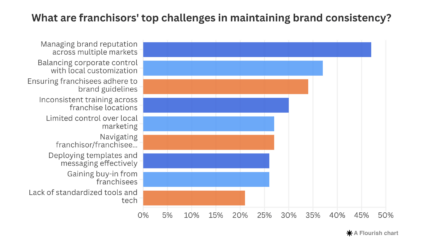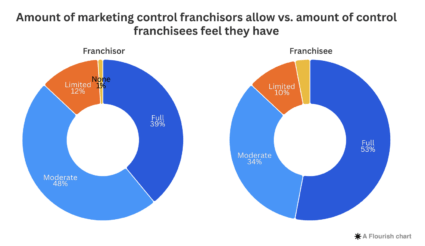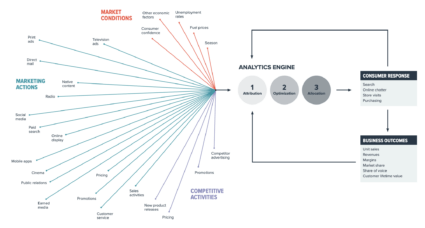From tariff headlines to stock market freefalls, 2025 has been full of surprises for brands—and not the fun kind.
All businesses are facing new challenges thanks to recent economic volatility, but franchises are in a unique position when it comes to creating a winning marketing strategy during economic bumps in the road.
Unlike your average brand, which has full control over strategy at all locations, franchises must find a way to bring together a cohesive message across many different franchisees. That’s especially hard when consumer sentiment is low and customers in different areas may have totally different pain points.
To win in today’s unpredictable economy, franchises have to be more resilient and flexible than ever to create a strategy that works across all markets without sacrificing brand reputation.
What tariffs, inflation, and low consumer confidence mean for franchise businesses
Franchises can’t take a one-size-fits-all approach to marketing through a rocky economy. Every headline hits a little differently for these businesses, which means each one requires a specialized response.
Tariffs are especially tough on franchises that depend on imports
Tariff policies have been evolving rapidly as President Trump has revised and delayed plans to implement new tariffs he claims will create more domestic factory jobs, lower food prices, and shrink the federal deficit, among other impacts.
Every day seems to bring a new take on which tariffs are being imposed and which are postponed or changed. No matter how the policies are ultimately executed, sweeping tariffs are likely to make a major mark on the US economy in the coming months. We’ve already seen a preview of these changes thanks to additional tariffs levied on Chinese products.
No business can avoid feeling the impact of tariffs entirely, but franchises may face more significant challenges since many are heavily reliant on global supply chains.
The effects tariffs will have vary widely based on the type of franchise:
- Restaurant: Will be hit hard as tariffs drive up prices on equipment, packaging, and food
- Gym: Tariffs will likely raise equipment costs, while gyms may struggle to compensate with higher membership fees as consumers tighten their belts
- Automotive: Foreign car parts and manufacturing will see rising prices
- Home Improvement: The cost of tools and materials will rise as tariffs take effect
- Retail: Rising costs of imported inventory may mean price hikes or lower profit margins
Other categories may have different outcomes–service-based industries, for example, will be less directly impacted, although they’ll still face higher prices for tools, tech, and more–but franchises overall are up against major changes. Businesses that are prepared to adapt quickly and diversify supply chains will rise to the top.
Low consumer sentiment poses a major challenge for franchises spread across different markets
As Americans face inflation, tariff confusion, and rising unemployment, consumer confidence has taken a serious dip, even among high earners who are usually insulated from bumps in the economic road.
According to the University of Michigan, consumer sentiment declined four months in a row before stabilizing in May, while Consumer Health Indexes’ outlook score for people in the top 10% of income earners dropped 11 points in April, according to data from Bain and Dynata.
That spells trouble for brands across the board as many Americans cut back on discretionary spending, but franchises in particular may have trouble adapting quickly to changing consumer sentiment.
While many businesses are able to pivot fast by making changes like switching sources for goods to markets with lower tariffs or revising messaging across different locations instantly, franchises are often weighed down by restrictions meant to standardize products and services across franchisees.
Franchisees usually have to stick to approved suppliers and meet specific quality assurance standards, limiting their freedom to make changes to lower costs or address new issues. They may have to wait a long time for approval from the franchisor on new moves (if they get it at all).
On the flip side, franchisors have their own headaches: it can be hard to get individual franchisees to make messaging or supplier changes quickly.
How Franchises Can Stay Flexible—Even When the Economy’s a Mess
As the economy continues to surprise us, franchises can benefit from the same changes as other businesses: diversifying supply chains, getting smart about pricing, and empathizing with customers.
But these businesses also need to take a specialized approach to make sure franchisees are set up for success in 2025’s ever-changing economic landscape.
Local Needs vs. Brand Control
Even in the best of times, franchises often struggle to strike a balance between creating a united strategy across all locations and giving franchisees the freedom to adapt to their specific markets.
47% of franchisors said managing brand reputation across multiple markets was their biggest challenge in maintaining brand consistency, according to a survey from Constant Contact and Ascend2.

Source: Constant Contact
A tough economic climate certainly doesn’t make it any easier, but there are tactics to help franchises keep up a holistic front no matter what. It all starts with open communication between the overall company and franchisees.
It helps to give franchisees the tools and training to handle marketing and finances on their own in a way that fits the overall brand. Franchisors should set up regular training to equip franchisees with up-to-date economic insights and best practices through resources like webinars, playbooks, and mentoring programs.
Giving franchisees financial literacy tools to help manage cash flow and respond to market shifts, and supplying templates, pre-built campaigns, and automation for marketing guidance can also help brands maintain a united front.

Source: Constant Contact
Unify data across different franchises
Franchises also face unique challenges when it comes to reporting. To support a marketing strategy across locations, it’s crucial to have a strong measurement framework in place that brings metrics from all franchisees together.
When franchisors don’t have visibility into franchisees’ marketing, it’s hard to collaborate on messaging and create shared best practices. But many franchises don’t have the reporting tools to achieve this.
According to a Constant Contact survey, only 38% of franchisors report having complete visibility into their franchisees’ marketing and communications programs, and just 37% of franchisors surveyed say their tools are very effective at helping them track marketing performance.
Franchises need a way to pull all their data into one place, bringing together metrics from across the business. That means breaking down walls between locations and channels. The best way to do this is by building an integrated framework with metrics from different franchisees, then incorporating that information into a media mix model like Wpromote’s Polaris Growth Planner to truly understand marketing’s impact.

Source: Harvard Business Review
Integrated measurement should also be accompanied by always-on incrementality testing, so you can continue to evolve the model assumptions as business, consumer, and media dynamics change.
Plan for what’s next—with the numbers to back it up
With that measurement framework in place, you can prepare for further economic challenges by using an MMM to simulate different “what if” scenarios and evaluate the impact of potential shifts in media spend.
Make sure the metrics you’re looking at align with your business’ overall financial priorities so you can get backing from executive leadership. If you can’t make a case to your CFO and board, even the best-laid plans will be over before they start.
You should also prepare messaging, creative assets, and templates for franchisees so you’re ready to switch out your creative quickly in different key scenarios.
Above all, make sure you’re staying up-to-date with new economic headlines. In a tough economy, your team needs to stay vigilant to keep up, especially since large franchises can have a hard time pivoting quickly. These strategies aren’t just about survival—they offer paths to sustainable growth, even in a challenging environment.







Responses